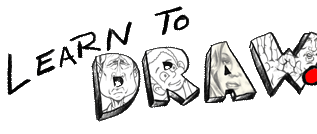 |
 |
|
Click to see Proportion in
action |
Proportion is getting the sizes of objects
correct in relation to other objects in a composition.
When you're dealing with Perspective as we just were,
you will also deal with Proportion. Since proportion is
getting the sizes of objects correct, when you're
creating a drawing that shows Perspective, you must get
the sizes of the objects correct as the objects recede
further away from view to properly illustrate
Perspective. If you are drawing from life and want to
make your drawing "look like" what it is you're drawing,
you'll need to get the proportions right. Here,
measuring is vital. You must measure the size of one
object in relation to another in your real-life subject,
then compare the sizes of the two objects in your
drawing. Measuring negative spaces against the real-life
subject and the drawing also need to be done in order to
get the proper proportion in a drawing. In the
previous measuring exercises with the fruit still
life, we were maintaining proportion because we were
measuring both shapes and negative spaces. Proportions
will be covered further and in more depth elsewhere on
this website.
Unfortunately, if your proportions are off on one
element of your drawing, it may throw the rest of the
composition off as well. As seen in the above portrait
drawing, Rick's nose is intentionally drawn too large,
which causes the other proportions on the face to off as
well. Obviously the nose is too long - but it's also too
wide. Because it's too long it means that the space
between the mouth and the nose is too short. And if you
measure in the photograph the width of the nose, and
compare that measurement to the width of the left eye,
you'll see that in the drawing the width of the drawn
nose is is also way off. And since the width of the nose
is off, that means that the space between the eyes is
also off. Here's a tip when you are drawing that will help keep
the proportions of your drawing proportional: When you
are drawing you should try and be aware of the whole
drawing before you have drawn the whole drawing. How the
heck can you do that?? For example, if you want to start
your drawing composition on the left side, then start
drawing on the left side of your paper. If you start
your drawing in the middle of the paper, you won't have
enough space to do the drawing and you'll crowd the
drawing on the right and possibly throw the proportions
off. Same goes with drawing from top to bottom. If you
start at the top, start the drawing at the top of the
paper. Another trick would be to try and gauge what
scale you want to do the drawing in. You don't have to
start thinking "ok, I want to draw a car - so I will
have to draw it at 1:83 scale in order to fit it on an 8
by 10 piece of paper." No, rather what you should try
is: using your pencil, measure the car's length and
height. Then still using your pencil as the "ruler" -
transfer those measurements onto your paper. What that
does is give you boundaries within which to do your
drawing so that you can get the drawing placed correctly
on the page. If you do these measurements to correctly
place your drawing on the paper, you will be able to
maintain correct proportions in your drawing because
you'll know the overall proportions of the completed
drawing before you finish it. Another thing that you'll
begin to do as you get more confident in your ability to
draw is to quickly sketch out the entire composition in
loose sketching that you can later "flesh out" as you
complete the drawing. On the right is a quick sketch of
two figures sitting at a table. The table is in one
point perspective, and the figures are loosely drawn in
so that the layout and proportions of the figures and
the table can be seen before the drawing is finished. |
